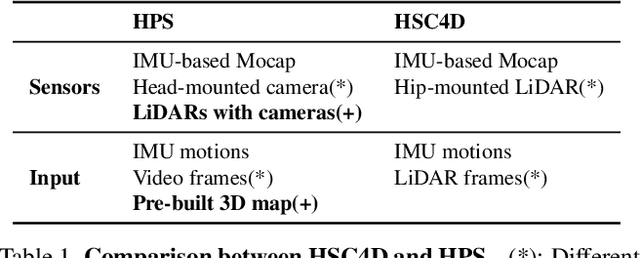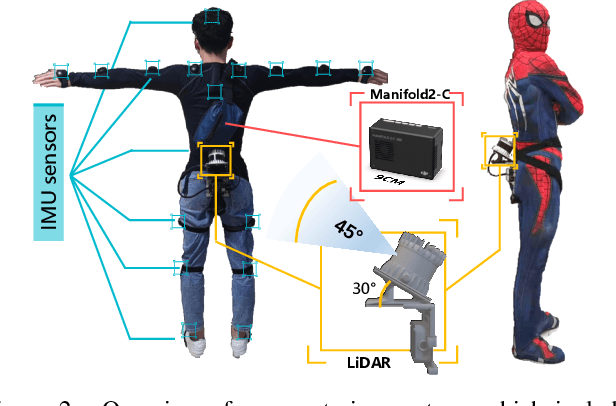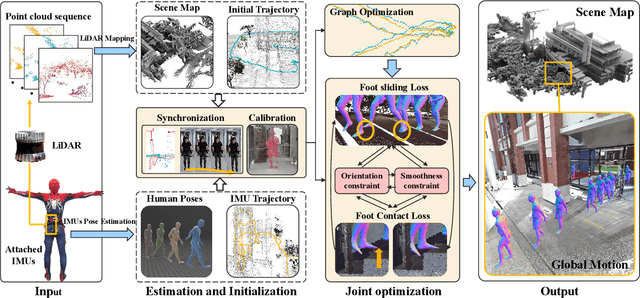Yitai Lin
Xiamen University, China
SLOPER4D: A Scene-Aware Dataset for Global 4D Human Pose Estimation in Urban Environments
Mar 18, 2023



Abstract:We present SLOPER4D, a novel scene-aware dataset collected in large urban environments to facilitate the research of global human pose estimation (GHPE) with human-scene interaction in the wild. Employing a head-mounted device integrated with a LiDAR and camera, we record 12 human subjects' activities over 10 diverse urban scenes from an egocentric view. Frame-wise annotations for 2D key points, 3D pose parameters, and global translations are provided, together with reconstructed scene point clouds. To obtain accurate 3D ground truth in such large dynamic scenes, we propose a joint optimization method to fit local SMPL meshes to the scene and fine-tune the camera calibration during dynamic motions frame by frame, resulting in plausible and scene-natural 3D human poses. Eventually, SLOPER4D consists of 15 sequences of human motions, each of which has a trajectory length of more than 200 meters (up to 1,300 meters) and covers an area of more than 2,000 $m^2$ (up to 13,000 $m^2$), including more than 100K LiDAR frames, 300k video frames, and 500K IMU-based motion frames. With SLOPER4D, we provide a detailed and thorough analysis of two critical tasks, including camera-based 3D HPE and LiDAR-based 3D HPE in urban environments, and benchmark a new task, GHPE. The in-depth analysis demonstrates SLOPER4D poses significant challenges to existing methods and produces great research opportunities. The dataset and code are released at \url{http://www.lidarhumanmotion.net/sloper4d/}
HSC4D: Human-centered 4D Scene Capture in Large-scale Indoor-outdoor Space Using Wearable IMUs and LiDAR
Apr 08, 2022



Abstract:We propose Human-centered 4D Scene Capture (HSC4D) to accurately and efficiently create a dynamic digital world, containing large-scale indoor-outdoor scenes, diverse human motions, and rich interactions between humans and environments. Using only body-mounted IMUs and LiDAR, HSC4D is space-free without any external devices' constraints and map-free without pre-built maps. Considering that IMUs can capture human poses but always drift for long-period use, while LiDAR is stable for global localization but rough for local positions and orientations, HSC4D makes both sensors complement each other by a joint optimization and achieves promising results for long-term capture. Relationships between humans and environments are also explored to make their interaction more realistic. To facilitate many down-stream tasks, like AR, VR, robots, autonomous driving, etc., we propose a dataset containing three large scenes (1k-5k $m^2$) with accurate dynamic human motions and locations. Diverse scenarios (climbing gym, multi-story building, slope, etc.) and challenging human activities (exercising, walking up/down stairs, climbing, etc.) demonstrate the effectiveness and the generalization ability of HSC4D. The dataset and code are available at http://www.lidarhumanmotion.net/hsc4d/.
 Add to Chrome
Add to Chrome Add to Firefox
Add to Firefox Add to Edge
Add to Edge